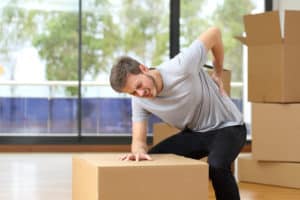
Why It Matters
You may think that this is an advice that’s most useful for times like moving, or the rare occasion you need to carry something heavy. But in reality, you bend down multiple times a day, even if it is to pick up something you dropped or to carry your children. These actions are second nature and you may not think about how you are doing them, or that they can be damaging your spine.
Usually doing this incorrectly one time is not always going to cause long term issues, but when you consistently repeat this action, it can lead to chronic pain. For some people, a single time may be enough to throw a back out completely.
The next time you bend down to pick something up, think through these four steps to see if you are lifting correctly!
1. Don’t Be Afraid To Show Some Booty
This one may seem silly at first, but it’s an important foundation to properly lifting! When people say “put your backside into it,” this is what they mean. You should essentially be squatting when you bend down- whether this means popping your rear out or hinging forward at your hips.
When you do this, both feet should be flat on the floor, including your heels. The proper form for squatting is to let your knees fall directly over your feet.
2. Lift Close to the Body
When you lift a heavy item, keeping it as close to your body as possible is an important way to counteract the weight. This prevents your lats (the muscles in your back) from having to work harder to support the weight of the object. If you are very fit, this may not be an issue, but for most of us, the muscles aren’t strong enough to lift in this way. When you strain these muscles, it also puts unwanted pressure on your spine, which can lead to a need for spinal decompression therapy in the future.
3. Stand Up Straight
Your mother might have been right on this one! Posture can be an important element of lifting correctly. As you squat, your chest should be high and your shoulders should be down. Slouching or hunching forward can cause serious damage to the spine when you are bending or lifting.
4. Tighten Your Glutes
Now that you are bent down in the correct position, it’s time to stand back up. To begin the lift, clench your glute muscles and gently pull your hips towards the item you are holding. As you stand, tighten your abdominal muscles and allow them to stabilize you. It is important to not twist during this process, standing up straight before making any turns.
Even when an item is not very heavy, a sudden twist can lead to spine injuries when you are in a partially bent position.
If you aren’t quite sure about the mechanics of this, practice in front of a mirror! This way you can see what others will see and ensure that your form is good.
What to Do If You Do Get Back Pain from Lifting
Even when you are careful, there can still be incidents where you injure your back lifting. If this happens, you should always visit a chiropractor quickly to assess the damage and determine a treatment plan quickly. At AICA Orthopedics, each patient receives a personalized examination to determine the cause of your injury. This helps us to determine the root cause of your pain and treat the problem at the source. Our goal is to provide customized care, whether it is chiropractic massage, spinal decompression, or orthopedic treatment, that allows you to get back to your previous quality of life quickly. Whether your back injury is old or new, contact AICA Orthopedics today to schedule your consultation with a chiropractor and begin creating a plan to reduce pain.
